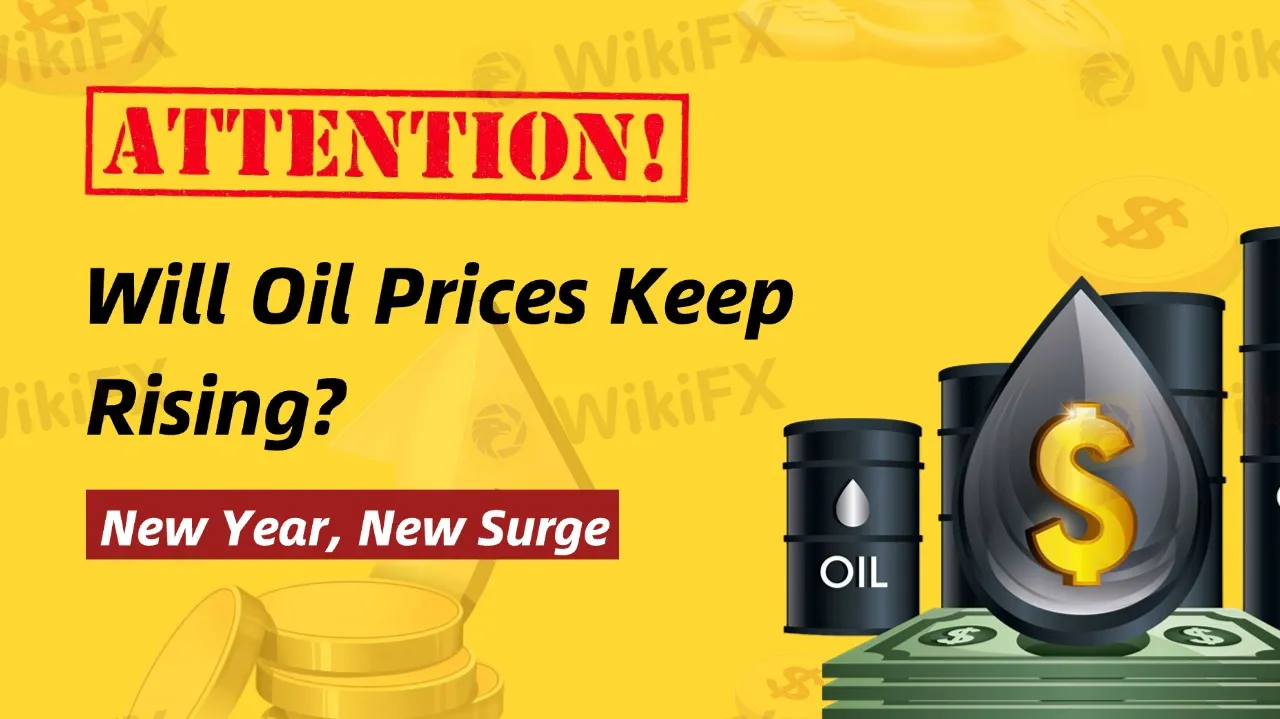简体中文
繁體中文
English
Pусский
日本語
ภาษาไทย
Tiếng Việt
Bahasa Indonesia
Español
हिन्दी
Filippiiniläinen
Français
Deutsch
Português
Türkçe
한국어
العربية
New Year, New Surge: Will Oil Prices Keep Rising?
Abstract:As of the writing of this article (January 2), oil prices stand at $71.88 per barrel. Investors need to continue monitoring whether the supply and demand dynamics will continue to push prices further up.

The outlook for crude oil supply in 2025 remains uncertain, but the short-term increase in demand has driven oil prices higher.
Oil price fluctuations are influenced by multiple factors, primarily including global supply and demand dynamics, geopolitical risks, crude oil inventory levels, and OPEC+ policies. Since the beginning of last year, OPEC+ has implemented production cuts, which have helped support oil prices.
However, between July and September, oil prices fell sharply due to a de-escalation in geopolitical risks, especially with the progress of the Israel-Palestine ceasefire talks, as well as capital market shocks that suppressed the valuations of risk assets like crude oil.
Geopolitical Influence
On the supply side, geopolitical tensions have provided some support for oil prices. If geopolitical tensions ease in 2025, this support could weaken, and oil prices may face downward risks. Investors should remain cautious about the potential for prices to drop again.
This week, attention should be focused on the EIA (U.S. Energy Information Administration) inventory data. According to the data released on December 31, U.S. oil production increased by 259,000 barrels per day in October, reaching a record high of 13.46 million barrels per day, driven by a surge in demand—the strongest since the pandemic.
The EIA forecasts that U.S. oil production will rise to a new record of 13.52 million barrels per day this year. However, some analysts believe that supply could tighten this year, particularly due to the policies of President-elect Trump, including sanctions on Iranian oil exports, which may provide short-term support for oil prices.

Impact of Fed Rate Cuts
At the same time, according to CMEs “FedWatch” tool, the probability of the Federal Reserve keeping rates unchanged in January 2025 is 88.8%, while the chance of a 25 basis point rate cut is 11.2%.
Typically, when the Federal Reserve cuts rates, the U.S. dollar depreciates, which in turn tends to push oil prices higher. Rate cuts increase market liquidity, lower borrowing costs, and stimulate economic demand, thereby driving up both oil demand and prices.
However, oil prices will still be affected by a combination of factors, including global economic conditions and geopolitical risks, so a comprehensive analysis of various dynamics is necessary.

Disclaimer:
The views in this article only represent the author's personal views, and do not constitute investment advice on this platform. This platform does not guarantee the accuracy, completeness and timeliness of the information in the article, and will not be liable for any loss caused by the use of or reliance on the information in the article.
Read more

KVB Global Exposed: High Slippage, Hidden Transaction Fees & Fund Scams
Does the MT4 platform provided by KVB Global minimize your actual profit? Does the broker deny your withdrawal request and instead tell you to deposit more? Have you faced hidden charges on blockchain transactions by the KVB Group? Have you witnessed massive fund scams while trading with the KVB broker? You need to act fast and even take legal assistance to recover your stuck funds. Several traders have alleged that KVB Global is involved in illegitimate trading activities. Check out their complaints in this KVB Global review.

Pocket Broker Review: Traders Furious Over Withdrawal Denials, Account Blocks & Price Manipulation
Does Pocket Broker ask you to verify the payment method repeatedly as you request fund withdrawals? Does the South Africa-based forex broker disallow you the same despite multiple verifications? Does your Pocket Broker forex trading account get blocked without any reason? Do the prices shown on the Pocket Broker login vary from real market prices? These are forex investment scams that Pocket Broker has been allegedly involved in. Read on to find more details.

Is MH Markets Safe or a Scam? Regulation and Fund Security Explained
Is MH Markets a real broker or a potential scam? This is the most important question for any trader thinking about using this platform. Let's give you a straight answer right away. MH Markets is a working broker, not a complete fake scam. Read on to learn more about this crucial due diligence you need to do as a trader.

Amillex Broker Login and Account Setup Guide 2025
You are here because you need clear instructions for the Amillex Broker login process or want to open a new Amillex Broker account. This guide is your complete resource. We provide a direct, step-by-step walkthrough for both new and existing traders. Our goal is to give you the exact information needed to access your account or get started with the platform safely and confidently. This complete manual covers everything from your first login to using your user dashboard and even setting up a practice account.
WikiFX Broker
Latest News
INTERPOL, AFRIPOL Crack Down on Africa Terror Finance
Forex Scam Checker Philippines: Verify Brokers with WikiFX
MH Markets Review 2025: Trading Platforms, Pros and Cons
Mekness Review: Traders Report Alleged Fund Scams & Account Blocks
Octa FX in Pakistan: The Complete Guide to Local Payments, Regulation, and Support
D Prime to Exit Limassol Office Amid Doo Group Restructure
WikiFX Elites Club Committee Concludes Voting! Inaugural Lineup Officially Announced
Fake Trading Platforms Are Spreading Fast Across Asia | How Investors Are Being Tricked
eToro CopyTrader Expands to U.S. Investors
Is MH Markets Safe or a Scam? Regulation and Fund Security Explained
Currency Calculator



